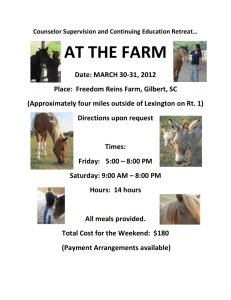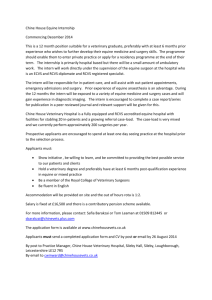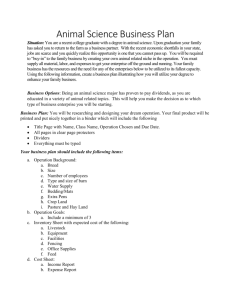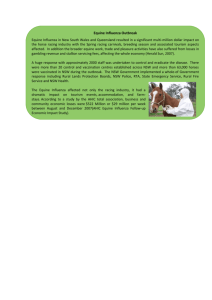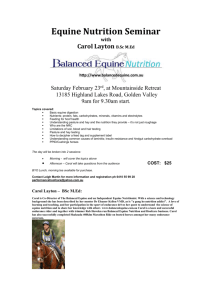Mr Russel Guire
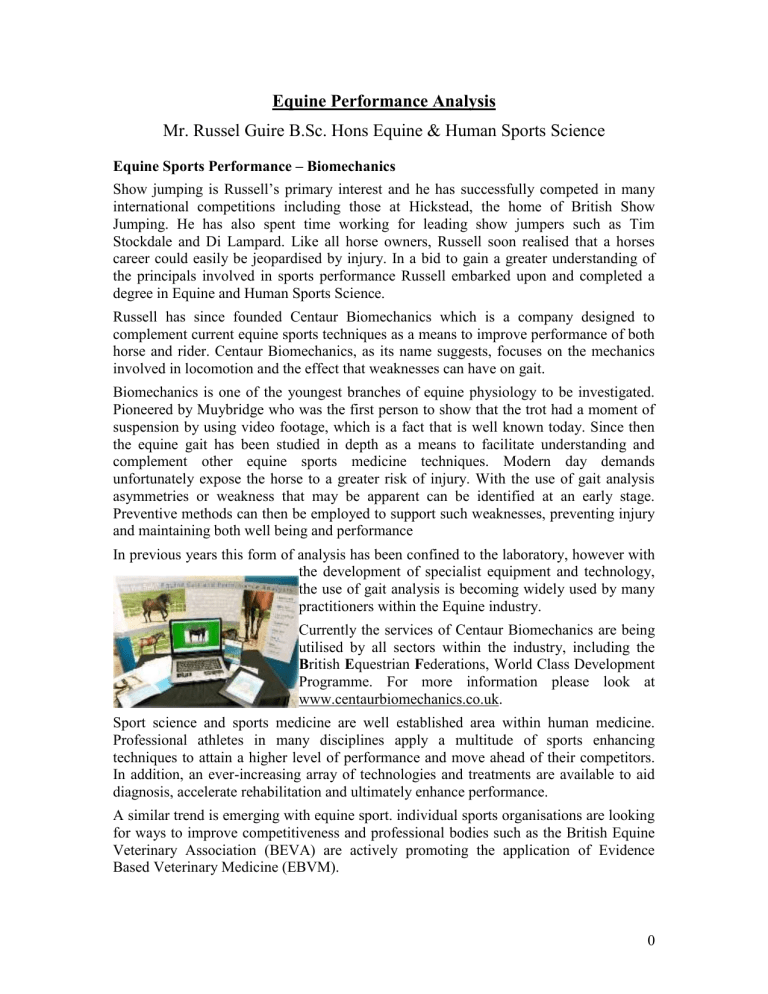
Equine Performance Analysis
Mr. Russel Guire B.Sc. Hons Equine & Human Sports Science
Equine Sports Performance – Biomechanics
Show jumping is Russell’s primary interest and he has successfully competed in many international competitions including those at Hickstead, the home of British Show
Jumping. He has also spent time working for leading show jumpers such as Tim
Stockdale and Di Lampard. Like all horse owners, Russell soon realised that a horses career could easily be jeopardised by injury. In a bid to gain a greater understanding of the principals involved in sports performance Russell embarked upon and completed a degree in Equine and Human Sports Science.
Russell has since founded Centaur Biomechanics which is a company designed to complement current equine sports techniques as a means to improve performance of both horse and rider. Centaur Biomechanics, as its name suggests, focuses on the mechanics involved in locomotion and the effect that weaknesses can have on gait.
Biomechanics is one of the youngest branches of equine physiology to be investigated.
Pioneered by Muybridge who was the first person to show that the trot had a moment of suspension by using video footage, which is a fact that is well known today. Since then the equine gait has been studied in depth as a means to facilitate understanding and complement other equine sports medicine techniques. Modern day demands unfortunately expose the horse to a greater risk of injury. With the use of gait analysis asymmetries or weakness that may be apparent can be identified at an early stage.
Preventive methods can then be employed to support such weaknesses, preventing injury and maintaining both well being and performance
In previous years this form of analysis has been confined to the laboratory, however with the development of specialist equipment and technology, the use of gait analysis is becoming widely used by many practitioners within the Equine industry.
Currently the services of Centaur Biomechanics are being utilised by all sectors within the industry, including the
B ritish E questrian F ederations, World Class Development
Programme. For more information please look at www.centaurbiomechanics.co.uk.
Sport science and sports medicine are well established area within human medicine.
Professional athletes in many disciplines apply a multitude of sports enhancing techniques to attain a higher level of performance and move ahead of their competitors.
In addition, an ever-increasing array of technologies and treatments are available to aid diagnosis, accelerate rehabilitation and ultimately enhance performance.
A similar trend is emerging with equine sport. individual sports organisations are looking for ways to improve competitiveness and professional bodies such as the British Equine
Veterinary Association (BEVA) are actively promoting the application of Evidence
Based Veterinary Medicine (EBVM).
0
Equianalysis is focused on bringing established human and equine sports products to the wider equine industry to aid diagnosis, promote health and enhance performance. Further focus will be on products and services that are non-invasive (and therefore easy-to-use and can be applied ‘’in the field’’) and support EBVM.
Currently the assessment of equine locomotion and lameness is carried out visually and cannot be reliably or consistently quantified. Equine practitioners often disagree on the extent of lameness. In addition the assessment cannot easily be communicated and has very little or no historic value. The objective measurement of lameness and changes in locomotion are the missing pieces of critical information needed to make key decisions related to equine health and performance.
For the last two years Equianalysis has been developing a video based equine gait analysis system in partnership with leading human biomechanics specialists. The system has been developed to address the need for lameness diagnosis, treatment monitoring and performance enhancement. It is currently being utilised within the elite sport of dressage as a method of objectively analysing equine gaits as a performance enhancing technique.
The application of the system is not limited to dressage, providing similar benefits for performance horses in general.
Centaur Biomechanics, in association with
Equinalysis, offers a unique service to the BEF and the World Class Development Programme.
The profiling of equines for individual conformation and locomotion using gait analysis is a pre-requisite to a greater understanding of the biomechanical joint and limb range of motions. As a direct result accurate individual biomechanical data can be extracted at any time allowing for a more informed decision making process especially when looking at poor performance and subtle lameness issues that can exist. This process also allows for the pro active monitoring of any effects that may result from changes made by veterinary, farriery and/or physiotherapy intervention.
Base line measurements can also be taken allowing for a more accurate mapping process throughout any stage of development and training. With the creation of the Equine
Pathway programme alongside current Start/Potential and Elite programmes Centaur
Biomechanics, in association with Equinalysis, plays an important part in the monitoring process looking not only at individual joint and limb loading but also forming an awareness of potential problems that continue to exist within the competition/performance sector.
Alongside equine gait analysis, Centaur Biomechanics provides performance analysis for the rider, working closely with both rider and trainer in targeting specific areas of analysis in order to facilitate the learning and understanding of the rider. Methods such as instant visual feedback, where the rider can see their performance projected onto a screen within the arena, this provides a benefit visually and also allows the trainer and rider to actively discuss the individual’s performance. Rider analysis allows the rider to bench
1
mark their performance, to which they can refer back to at a later date and note any changes in both their riding and the horse’s way of going.
Equine gait analysis and rider analysis is becoming an invaluable tool in both performance and training, especially when looking forward to the 2012 London
Olympics.
For more information please look at www.centaurbiomechanics.co.uk.
2


